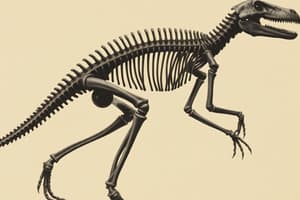Podcast
Questions and Answers
What is the process by which the bones of the limb are formed?
What is the process by which the bones of the limb are formed?
- Exochondral ossification
- Endochondral ossification (correct)
- Intrachondral ossification
- Interchondral ossification
What determines where limbs form, promotes limb bud outgrowth and patterning, and specifies fates along the anteroposterior and dorsoventral axes?
What determines where limbs form, promotes limb bud outgrowth and patterning, and specifies fates along the anteroposterior and dorsoventral axes?
- Signals from the flank and apical ectodermal ridge (AER) (correct)
- Signals from the somitic and lateral plate mesoderm
- Signals from the neural crest cells
- Signals from the Hox genes
What is the name of the Devonian fossil that had fishlike gills, fins, scales, and a lack of neck, but also had fingers?
What is the name of the Devonian fossil that had fishlike gills, fins, scales, and a lack of neck, but also had fingers?
- Ichthyostega
- Eusthenopteron
- Tiktaalik roseae (correct)
- Acanthostega
What is the name of the genes that influence the evolution of fins to fingers?
What is the name of the genes that influence the evolution of fins to fingers?
What is the name of the process by which tetrapod limbs begin as buds of tissue on the sides of the embryo and grow into a set of digits with joints between the bones?
What is the name of the process by which tetrapod limbs begin as buds of tissue on the sides of the embryo and grow into a set of digits with joints between the bones?
What is the name of the fossil record that points to an important transition in forelimb morphology from pectoral fins of ray-finned fish to digited limbs of the tetrapod?
What is the name of the fossil record that points to an important transition in forelimb morphology from pectoral fins of ray-finned fish to digited limbs of the tetrapod?
What is the name of the specific regions of somitic and lateral plate mesoderm that are determined to form limbs long before any visible signs of wings or legs emerge?
What is the name of the specific regions of somitic and lateral plate mesoderm that are determined to form limbs long before any visible signs of wings or legs emerge?
Flashcards are hidden until you start studying
Study Notes
The Development of Tetrapod Limbs and the Evolution of Fingers
- Tetrapod limbs begin as buds of tissue on the sides of the embryo and grow into a set of digits with joints between the bones.
- The skeletal pattern of the human arm, chick wing, and horse forelimb is similar, with fingers and toes referred to as phalanges.
- The positional information needed to construct a limb has to function in a three-dimensional coordinate system, and the bones of the limb are formed by endochondral ossification.
- The Hox genes influence the evolution of fins to fingers, and Hox genes specify whether a particular mesenchymal cell will become stylopod, zeugopod, or autopod.
- Humans homozygous for a HOXD13 mutation have abnormalities of their hands and feet, and humans with homozygous mutant alleles of HOXA13 have deformities of their autopods.
- The fossil record points to an important transition in forelimb morphology from pectoral fins of ray-finned fish to digited limbs of the tetrapod, which allowed aquatic life to explore terrestrial habitats.
- The Devonian fossil Tiktaalik roseae, a "fish with fingers," highlights the importance of joint development in limb evolution and had fishlike gills, fins, scales, and a lack of neck.
- During limb development, Hox genes are regulated by signals from the flank and apical ectodermal ridge (AER), which determine where limbs form, promote limb bud outgrowth and patterning, and specify fates along the anteroposterior and dorsoventral axes.
- Experiments have shown that certain basic "morphogenetic rules" for forming a limb appear to be the same in all tetrapods, and that regenerating salamander limbs appear to follow many of the same rules as developing limbs.
- Early fate mapping and transplantation studies in the chick demonstrated that two specific regions of somitic and lateral plate mesoderm are determined to form limbs long before any visible signs of wings or legs emerge.
- Vertebrates have four limb buds per embryo, and the position of the limb buds is constant with respect to the level of Hox gene expression along the anterior-posterior axis.
- The developmental biologist is interested in how vertebrates have four limbs and not six or eight, and how the little finger develops at one edge of the limb and the thumb at the other.
Studying That Suits You
Use AI to generate personalized quizzes and flashcards to suit your learning preferences.




